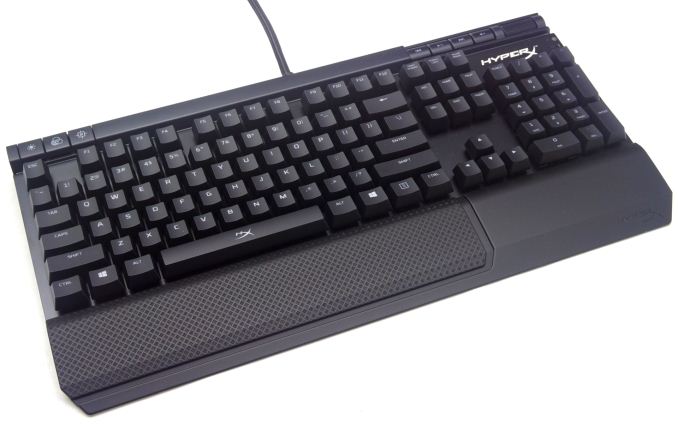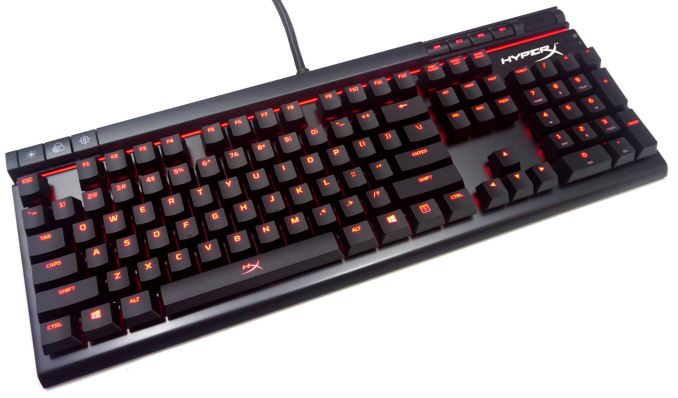The Kingston HyperX Alloy Elite Mechanical Keyboard Review
by E. Fylladitakis on July 17, 2017 6:15 AM EST- Posted in
- Keyboard
- Kingston
- HyperX
- Cherry MX
- Mechanical Keyboards
Conclusion
Kingston released the HyperX Alloy Elite as a step forward from the Alloy FPS, a gaming keyboard that was designed to be minimalistic, compact and easy to carry around. The Alloy Elite is a design that ditches the portability for additional practical features, making geared towards gamers who do not plan on frequently moving it around. Despite the “Elite” characterization, the company did not try to pack the keyboard with features, nor did they step into the RGB quadrant. (Or at least not yet, as the company does have an RGB version of the Alloy Elite planned for the future.)
The HyperX Alloy Elite is a product of excellent overall quality. Cherry’s mechanical switches are of renowned quality and the thick steel frame makes it almost impervious to damage. Internally, the assembly job is immaculate. Even the plastic top bar that holds the low-profile buttons and volume wheel is very thick and well designed, although it is not as resistant to scratches as the metal top plate is. The weak part of the Alloy Elite is the plastic volume wheel. It works and feels great but its plastic axle will definitely not survive a serious blow. Gamers with temper issues should aim their punches elsewhere.
Moving on, due to its soft, responsive Cherry MX Red switches, the HyperX Alloy Elite is something I consider very comfortable for prolonged gaming sessions. Some gamers may dislike the standard bottom row – as they may be accustomed to expanded Spacebar keys – but most will endorse its implementation, especially modders that enjoy swapping their keycaps. For professional use, the HyperX Alloy Elite is comfortable when the typist can type without bottoming down most of the keystrokes. The softness of the keys can make this a little difficult at first and the lack of feedback does not help but, once mastered, the HyperX Alloy Elite is very comfortable for professional use, especially if there are other people in the vicinity of the user.
The Achille’s heel of the HyperX Alloy Elite is its simplicity, especially in such a competitive market. When gamers decide to invest over $100 for a quality mechanical keyboard, they usually want it to be loaded with all the bells and whistles. Most >$100 keyboards are fully programmable and come with proper software for it, or at least feature basic hardware macro programming. The Alloy Elite completely lacks programmability, which although doesn't hurt its basic keyboard functions in any way, leaves it at a competitive disadvantage. Otherwise, despite its popularity, we do not consider RGB lighting to be a vital feature and we certainly enjoyed the clear, even backlighting of the Alloy Elite. However, there are also many mechanical keyboards that feature programmable RGB lighting that are currently selling for less than $100, making the Alloy Elite an even less competitive option.
What Kingston wanted to do is to develop a high quality, beautiful mechanical keyboard that can retail at an affordable price – something that is more practical for everyday use than the Alloy FPS, yet not significantly more expensive. The Alloy FPS, however, had very little competition to deal with, as there were very few really compact full-size mechanical keyboards available. We feel that Kingston is diving into dangerous waters with the HyperX Alloy Elite, as the competition it is going to face will be enormous. A few years ago, $110 for a high-quality gaming mechanical keyboard would be a reasonable investment. Today there are myriads of mechanical keyboards available around this price range, with some offering full advanced programmability, some programmable RGB lighting, and some even both at the same time. Although the HyperX Alloy Elite is a very high-quality product, we feel that it will be very difficult for Kingston to stand above the pack in a rather crowded keyboard market.












32 Comments
View All Comments
Pinkynator - Monday, July 17, 2017 - link
I'm honestly wondering if I'll ever be able to buy a mechanical keyboard. They all have the US layout, making them utterly worthless for a very, very large part of the world.philehidiot - Monday, July 17, 2017 - link
I got a UK layout one without any issue from Amazon. Getting it to work was however an issue due to Razor screwing it up but hey. 3 or so years after buying it, the bugger finally works properly.DanNeely - Monday, July 17, 2017 - link
The US layout ones might have an overwhelming advantage in sending product to international review sites. A quick check on Amazon.co.uk shows a number of UK layout ones though. Google shows at least a few French/German layout ones as well. If you're looking for specific advanced features, you might not be able to find one directly; but (assuming I can trust wikipedia anyway) the physical layouts for both are the same as for the UK. That means you should just need to buy replacement key caps and tell the OS to treat it as your native layout.https://www.amazon.co.uk/s/ref=nb_sb_ss_i_1_16?url...
Pinkynator - Tuesday, July 18, 2017 - link
My problem is that I'd have to get something imported... Customs, taxes, shipping, just awful. I drooled over WASD, but in the end, I realized it would probably cost over $400 (converted) to buy one of those. And that still leaves the keycap issue - I have small and big family members needing to use that keyboard, and they can't do it if it's not fully localized.mr_tawan - Tuesday, July 18, 2017 - link
If you're in the area that people use ISO layout (says ... Canada), you should have no problem getting one without importing.If you're in the USA, where people use ANSI layout, then you might have to import.
wsjudd - Monday, July 17, 2017 - link
There are plenty of rest-of-world models available. These are called ISO, so if you search 'mechanical keyboard ISO' or 'mechanical keyboard UK' then you should find a lot of examples on Google, Amazon, eBay, KeyboardCo, etc.andychow - Monday, July 17, 2017 - link
What are you talking about? All mechanical keyboards have that tool, pictured in this article and talked about, that you can use to remove the key-caps and arrange them however way you want. If you're talking about the "missing" key next to the left shift, it's above the enter key. Doesn't make it utterly worthless at all.Calin - Monday, July 17, 2017 - link
Good luck then moving your keycaps to show on the same keycap both ; and , (as on German keyboards)andychow - Monday, July 17, 2017 - link
Do you even look at your keyboard when typing? And if you do, you can buy custom keycaps, and just the individual ones you want for any language.Pinkynator - Tuesday, July 18, 2017 - link
There actually *IS* a missing key. Don't put it under quotes. The US keyboard has 104 keys, but normal keyboards have 105.